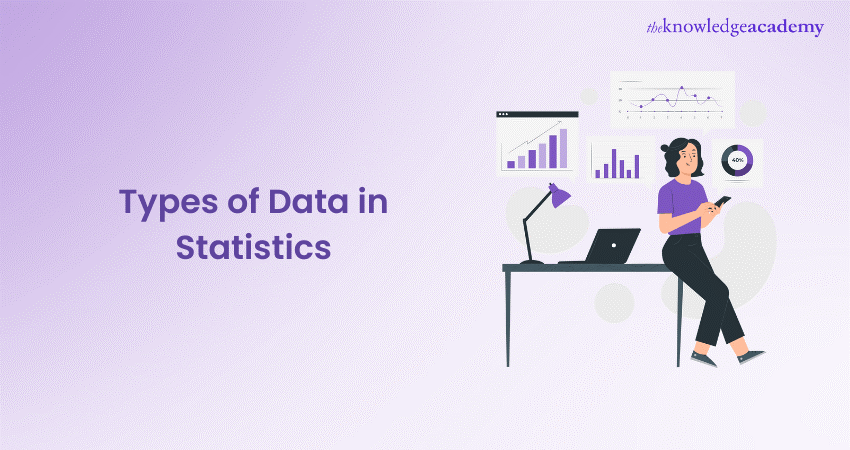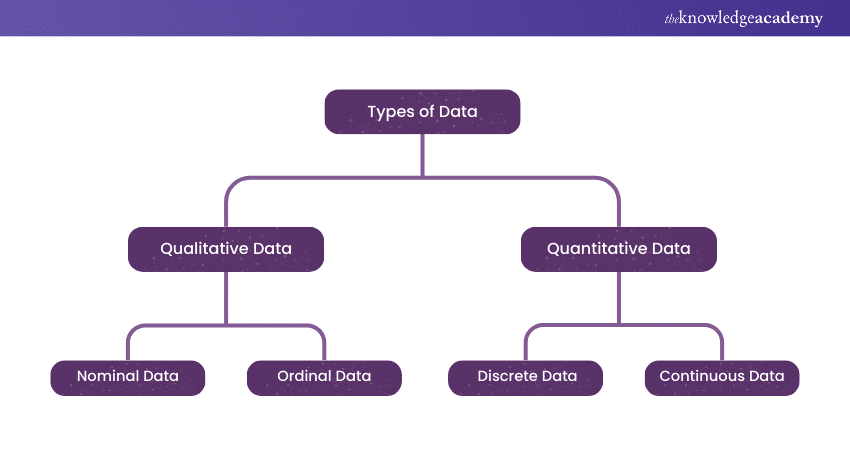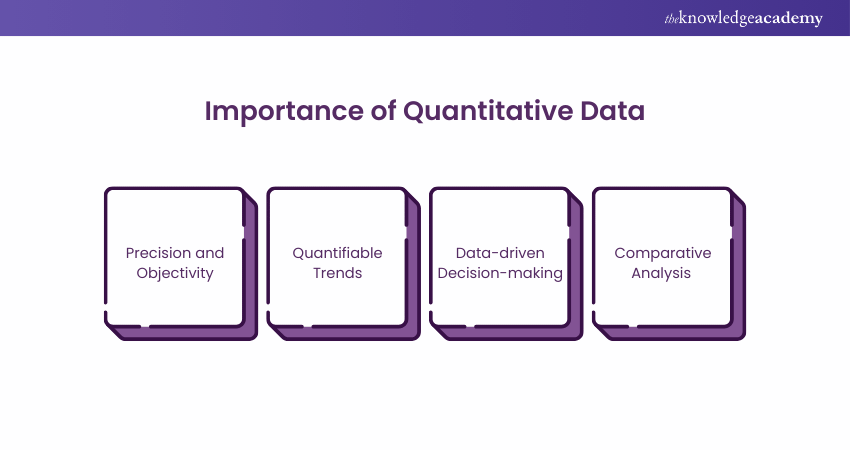We may not have the course you’re looking for. If you enquire or give us a call on + 1-866 272 8822 and speak to our training experts, we may still be able to help with your training requirements.
We ensure quality, budget-alignment, and timely delivery by our expert instructors.

In Statistics, Data is central to all the activities of analysis and decision-making. It offers the starting point from which developing insights, trends and patterns are derived. It is important to recognise the Types of Data in Statistics because the kind of Data that you have influences the statistical techniques you will use.
Poor Data quality and mischaracterisation cost organisations an average of 15 million per year according to Gartner. If you are interested in the Data analysis industry and are in need of detailed tutorials, or you want to be acquainted with the fundamentals of the Data analysis industry, then this blog is for you.
Thus, in this blog, we shall try to explain the Types of Data in Statistics: Yes, you asked, and we shall correspond; we will provide a host of examples to explain the Types of Data in Statistics.
Table of Contents
1) Introduction to Data and its Types in Statistics
2) Different Types of Data in Statistics
3) Importance of Qualitative and Quantitative Data
4) Difference between Qualitative and Quantitative Data
5) Conclusion
Introduction to Data and its Types in Statistics
Data forms the bedrock of Statistical Analysis, serving as the building blocks upon which insights, patterns, and decisions are constructed. Data is systematically categorised in Statistics into distinct types, each with unique characteristics and significance. Understanding these types is fundamental to any Data-driven discipline.
Data is a collection of facts, figures, observations, or information, typically presented in numerical or non-numerical form. To understand data in detail, one must first comprehend the fundamental division of Data: Qualitative and Quantitative. When exploring Data Science Vs Statistics, it's essential to recognise how each field analyses and interprets data, highlighting the differences in approach and application.
1) Qualitative Data: Qualitative or Categorical Data encompasses non-numerical information categorised into groups or classes. This type of Data includes Nominal Data, which has categories without a specific order (e.g., types of fruits), and Ordinal Data, where categories possess a meaningful order (e.g., educational levels).
2) Quantitative Data: Quantitative Data, on the other hand, involves numerical values representing quantities or measurements. It can be further categorised as Discrete Data, consisting of countable, distinct values (e.g., the number of students in a class), and Continuous Data, characterised by measurements that can take on an infinite number of values within a range (e.g., height or temperature readings).
Different Types of Data in Statistics
The following are the different types of Data in Statistics:

Qualitative Data
Qualitative Data, or Categorical Data, is crucial in capturing non-numerical information. It's a valuable form of Data that helps classify and categorise elements into distinct groups, providing valuable insights into various aspects of research and analysis. Two primary subtypes of Qualitative Data are Nominal and Ordinal Data.
Nominal Data
Nominal Data represents categories or labels without any inherent order or ranking. These categories serve as identifiers, allowing us to group Data into discrete classes. Nominal Data is characterised by its distinct and unrelated categories, and it's often used for classifying Data based on attributes. Here are a few key features of Nominal Data:
a) No Order: The categories in Nominal Data have no specific order or ranking. For example, if we're categorising types of fruits as apples, oranges, and bananas, these categories have equal standing and do not imply any inherent order.
b) Distinct Labels: Each category in Nominal Data is distinctly labelled, making identifying and classifying elements easy.
Examples:
a) Types of Pets: e.g., dogs, cats, birds
b) Marital Status: e.g., married, single, divorced
c) Colours: e.g., red, blue, green
Nominal Data is often analysed using frequency tables and bar charts, making it helpful in summarising and visualising categorical information.
Ordinal Data
Ordinal Data, on the other hand, represents categories or labels with a meaningful order or ranking. While Nominal Vs Ordinal Data retains the categorical nature of Nominal Data, Ordinal Data adds a layer of information by indicating that one category is "greater" or "better" than another. However, it's important to note that the intervals between these categories are not necessarily equal. Key characteristics of Ordinal Data include:
a) Order: The categories in Ordinal Data have a specific order or ranking, reflecting a progression from a lower to a higher state. For example, in a survey that collects customer satisfaction ratings ranging from "very dissatisfied" to "very satisfied," the order is evident.
b) Non-equidistant Intervals: Unlike interval or ratio Data, Ordinal Data does not have equal gaps between categories. The difference between categories may vary.
Examples:
a) Educational Levels: e.g., elementary, high school, college
b) Socioeconomic Status: e.g., low-income, middle-income, high-income
c) Movie Ratings: e.g., one star, two stars, three stars
Analysing Ordinal Data involves recognising the order of categories and using Statistical methods appropriate for ordinal scales, such as Spearman's Rank Correlation coefficients and non-parametric tests.
Learn statistics the easy way! Download our Statistics PDF to boost your knowledge.
Quantitative Data
Quantitative Data is a fundamental component of Statistics, providing a numerical foundation for analysis and decision-making. It includes a wide range of numerical values that represent quantities, measurements, and observations. Two primary categories within Quantitative Data are Discrete Data and Continuous Data.
Discrete Data
Discrete Data consists of countable, distinct values that are often whole numbers and cannot be broken down into smaller parts. These values result from counting or enumerating items or occurrences. Discrete Data is prevalent in various fields and applications, including business, science, and social sciences. Key characteristics of Discrete Data are:
a) Countable Values: Discrete Data consists of values that are distinct and countable. This means you can list or enumerate all the possible values within the Dataset.
b) Gaps Between Values: In a Discrete Dataset, apparent gaps or intervals exist between the values. These gaps indicate that there are no values between the specified Data points.
Examples of Discrete Data:
a) Number of Customers: In retail, businesses track the number of customers entering their stores daily. This count yields Discrete Data, as you cannot have a fraction of a customer.
b) Student Grades: Grading systems typically use discrete values such as A, B, C, D, and F to represent academic performance. Each grade represents a distinct category.
c) Dice Rolls: When rolling a six-sided dice, the possible outcomes are discrete and countable, ranging from 1 to 6.
Discrete Data is often analysed using Statistical techniques tailored to discrete variables, such as frequency distributions, bar charts, and probability calculations. These methods help to summarise and interpret Data that can be counted or categorised into distinct values.
Continuous Data
Continuous Data, in contrast, represents measurements that can take on an infinite number of values within a given range. These values are typically expressed as decimals or fractions and can be divided into smaller and smaller intervals. Continuous Data is essential in scientific research, engineering, and numerous other fields where precision and accuracy are crucial. Continuous Data is characterised by two key features:
a) Infinite Possible Values: Continuous Data can take on infinite values within a given range. This means that there are countless other potential values between any two Data-points.
b) No gaps or Discontinuities: Continuous Data has no gaps, breaks, or discontinuities between values. In other words, it can be measured with great precision, and there are no distinct, separate categories or intervals.
Examples of Continuous Data:
a) Height of Individuals: Heights can vary continuously, from fractions of an inch to several feet. Measuring the height of people yields Continuous Data.
b) Temperature Readings: Temperature measurements can include decimal values and vary continuously, ranging from below freezing to triple digits above zero.
c) Weight of Products: In manufacturing and commerce, the weight of products is often measured with precision, resulting in Continuous Data.
Continuous data is typically analysed using statistical techniques for continuous variables, such as histograms, scatter plots, and probability density functions. These methods help to visualise and analyse data with infinite possible values within a specified range. To further enhance the analysis, a Regression Analysis Guide can provide insights into how to model and interpret the relationships between continuous variables, improving the accuracy of your data-driven decisions.
Elevate your Data science skills with our Probability and Statistics for Data Science Training - unlock the power of Data insights!
Importance of Qualitative and Quantitative Data
Qualitative and Quantitative Data are two distinct but equally valuable types of information that play crucial roles in various fields, from scientific research to business decision-making. Each type offers unique insights and benefits, making them indispensable tools for understanding the world around us.
Qualitative Data
The following are the key points of the importance of Qualitative Data:

a) Context and depth: Qualitative Data provides context and a deeper understanding of complex phenomena. It captures the richness of human experiences, emotions, and behaviours, making it essential in psychology, sociology, and anthropology.
b) Exploration and hypothesis generation: It is often used to explore new topics and generate hypotheses. Researchers can use Qualitative Data to uncover trends, patterns, and potential relationships that may later be tested quantitatively.
c) Human-centred insights: In business and marketing, Qualitative Data helps organisations gain insights into customer preferences, motivations, and pain points. It aids in designing products and services that align with customer needs.
Quantitative Data
The following are the key points of the importance of Quantitative Data:

a) Precision and Objectivity: Quantitative Data offers precision and objectivity. It provides numeric measurements that can be analysed Statistically, allowing for rigorous testing of hypotheses and drawing Statistically significant conclusions.
b) Quantifiable Trends: In fields like microeconomics, economics, medicine, and environmental science, Quantitative Data helps track trends over time, making it possible to identify patterns, make predictions, and assess the impact of interventions.
c) Data-driven Decision-making: In business and government, Quantitative Data guides Data-driven decision-making. It aids in evaluating the effectiveness of policies, optimising processes, and measuring performance.
d) Comparative Analysis: Quantitative Data allows for comparative analysis, enabling researchers to assess the relationships between variables and determine the strength and direction of those relationships.
Unlock the power of Data with our Data Science with R Training – Register today and transform your career!
Difference Between Qualitative and Quantitative Data
Qualitative and Quantitative Data are two fundamental types of Data used in various fields, including science, social sciences, business, and Statistics. They differ in nature, purpose, and the methods used for collection and analysis. Understanding the distinctions between these two Types of Data in Statistics is crucial for researchers and analysts to choose appropriate approaches for their investigations.
Nature
1) Qualitative Data: Qualitative Data, also known as Categorical Data, is descriptive in nature. It deals with non-numeric information that can be categorised into groups or classes. Qualitative Data often involves attributes, characteristics, or qualities. Examples include colours, types of animals, and job titles.
2) Quantitative Data: Quantitative Data, in contrast, is numeric and measurable. It represents quantities, counts, or measurements and can be expressed numerically. Examples include height, temperature, income, and the number of products sold.
Purpose
Qualitative Data: Qualitative Data is primarily used for classification and categorisation. It helps researchers understand the characteristics or attributes of items under study. Quantitative Data is focused on quantifying and measuring phenomena. It allows researchers to perform mathematical and statistical analyses, including concepts from Discrete Mathematics, enabling precise comparisons, predictions, and hypothesis testing.
Quantitative Data: Quantitative Data is focused on quantifying and measuring phenomena. It allows researchers to perform mathematical and Statistical Analyses, enabling precise comparisons, predictions, and hypothesis testing.
Data collection
Qualitative Data: Qualitative Data is collected through interviews, surveys, observations, and content analysis. Researchers often use open-ended questions to gather rich, narrative responses that can be categorised later.
Quantitative Data: Quantitative Data is typically collected using structured surveys, experiments, measurements, and numerical instruments. Closed-ended questions and standardised measurements are common in Quantitative Data collection.
Analysis
Qualitative Data: Qualitative Data analysis involves identifying patterns, themes, and trends through coding, content analysis, and thematic analysis. It requires a more subjective interpretation of Data.
Quantitative Data: Quantitative Data analysis employs Statistical methods to analyse Data, including measures of central tendency, dispersion, hypothesis testing, and regression analysis. It provides objective and numerical insights into the Data.
Example
To illustrate the difference, consider a study on customer feedback for a restaurant:
Qualitative Data might include customer comments about the restaurant's ambience, service, or menu. Researchers would categorise these comments into themes like "positive feedback," "complaints," or "suggestions."
Quantitative Data would involve collecting numerical ratings (e.g., on a scale of 1 to 5) for various aspects of the restaurant, such as food quality, service speed, and cleanliness. Researchers could then calculate average ratings and conduct Statistical analyses to identify areas for improvement.
Conclusion
In Statistics, Data comes in various forms, each with its unique characteristics and applications. Understanding the different Types of Data in Statistics—Qualitative (nominal and ordinal) and Quantitative (discrete and continuous)—is essential for selecting the appropriate Statistical methods and drawing meaningful conclusions from your Data.
Unlock your Data-driven potential with our comprehensive Data Science Training!
Frequently Asked Questions
What are Some Common Methods for Analysing Qualitative Data?

Some strategies of the analysis of qualitative data are theming (pattern identification), textometry (features of written texts), storyology (stories), abduction of theory (creation of theories), and framing (matrix).
Can Qualitative Data be Converted to Quantitative Data?

It must be understood that coding and categorisation enables the conversion of qualitative data into quantitative data. For example, subject areas emerging from interviews can be attached to numbers or counts. This research approach enables the measurement of developed qualitative theories.
What are the Other Resources and Offers Provided by The Knowledge Academy?

The Knowledge Academy takes global learning to new heights, offering over 3,000 online courses across 490+ locations in 190+ countries. This expansive reach ensures accessibility and convenience for learners worldwide.
Alongside our diverse Online Course Catalogue, encompassing 19 major categories, we go the extra mile by providing a plethora of free educational Online Resources like News updates, Blogs, videos, webinars, and interview questions. Tailoring learning experiences further, professionals can maximise value with customisable Course Bundles of TKA.
What is The Knowledge Pass, and How Does it Work?

The Knowledge Academy’s Knowledge Pass, a prepaid voucher, adds another layer of flexibility, allowing course bookings over a 12-month period. Join us on a journey where education knows no bounds.
What are the Related Courses and Blogs Provided by The Knowledge Academy?

The Knowledge Academy offers various Data Science Courses, including the Python Data Science Course, Data Science with R Training and the Data Science and Blockchain Training. These courses cater to different skill levels, providing comprehensive insights into Data Science Tools and Key Concepts.
Our Data Analytics and AI Blogs cover a range of topics related to Data Science Courses, offering valuable resources, best practices, and industry insights. Whether you are a beginner or looking to advance your Data Management skills, The Knowledge Academy's diverse courses and informative blogs have got you covered.
Upcoming Data, Analytics & AI Resources Batches & Dates
Date
 Python Data Science Course
Python Data Science Course
Mon 26th May 2025
Mon 14th Jul 2025
Mon 22nd Sep 2025
Mon 24th Nov 2025
Mon 8th Dec 2025






 Top Rated Course
Top Rated Course



 If you wish to make any changes to your course, please
If you wish to make any changes to your course, please


